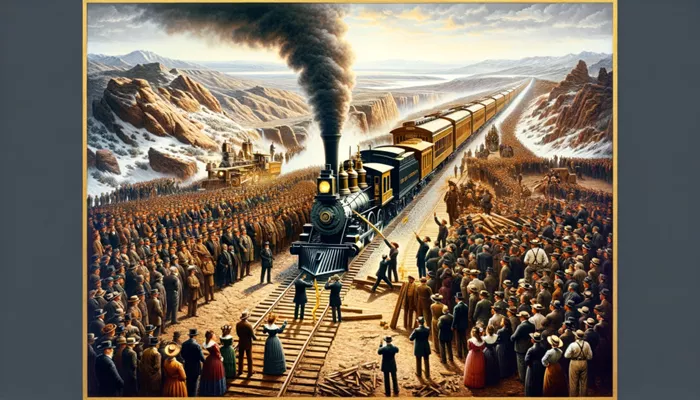Throughout American history, May 10 has been a day of great significance. On this day, major political, military, and cultural events have taken place, shaping the country’s course. Below is a detailed account of key events that occurred on May 10 in different years.
What Happened on May 10 in American History?
1. The Completion of the First Transcontinental Railroad (1869)
One of the most important events in American history happened on May 10, 1869. On this day, the Central Pacific and Union Pacific Railroads were joined at Promontory Summit, Utah. This momentous occasion marked the completion of the First Transcontinental Railroad, which revolutionized travel and trade across the United States.
Before this railway, traveling from the east to the west coast was difficult. It required months of journeying by wagon or ship. The completion of the railroad shortened travel time to just a few days. It also boosted economic growth, as goods and people could move faster across the country. The ceremonial joining of the tracks was symbolized by the driving of the famous golden spike.
The completion of the railroad was made possible by thousands of workers, including many Chinese and Irish immigrants. These laborers worked under harsh conditions to lay the tracks across the rugged terrain of the American West. Their efforts helped to unify the nation and spur further development.
2. The Capture of Fort Ticonderoga (1775)
During the early stages of the American Revolutionary War, an important military victory occurred on May 10, 1775. On this day, the Green Mountain Boys, led by Ethan Allen and Benedict Arnold, captured Fort Ticonderoga from the British.
Fort Ticonderoga was located in present-day New York. It was strategically important because it controlled access to the Hudson River and Canada. The capture of the fort was a surprise attack. The American forces approached in the early morning while the British garrison was unprepared. The fort was taken with little resistance, and the Americans secured valuable artillery.
Later, the cannons from Fort Ticonderoga were transported to Boston by Colonel Henry Knox. These weapons were used to force the British to evacuate the city in 1776. The capture of Fort Ticonderoga was one of the first American victories in the Revolutionary War. It helped boost morale and strengthen the fight for independence.
3. The End of the Confederate Government (1865)
The American Civil War ended in April 1865 with the surrender of Confederate General Robert E. Lee. However, some members of the Confederate government attempted to continue the fight. On May 10, 1865, Confederate President Jefferson Davis was captured by Union forces in Georgia.
Davis had fled the Confederate capital of Richmond, Virginia, in early April. He and his remaining government officials moved south, hoping to reorganize their forces. However, Union troops pursued them relentlessly. On May 10, Davis was caught near Irwinville, Georgia. He was taken as a prisoner and held in captivity for two years before being released.
The capture of Jefferson Davis signified the complete collapse of the Confederacy. It ended any hope of prolonging the war. This event marked a turning point in the Reconstruction Era, as the country began the difficult process of reunification.
4. J. Edgar Hoover Becomes FBI Director (1924)
On May 10, 1924, J. Edgar Hoover was appointed as the director of the Bureau of Investigation, later known as the Federal Bureau of Investigation (FBI). Hoover’s appointment marked the beginning of one of the most influential law enforcement careers in American history.
At the time of Hoover’s appointment, the Bureau was plagued by corruption and inefficiency. Hoover introduced strict hiring standards, requiring agents to be highly educated and well-trained. He also implemented modern investigative techniques, including fingerprint databases and crime laboratories.
Hoover remained the head of the FBI until his death in 1972. During his tenure, he oversaw major cases, including the fight against organized crime and the Cold War espionage investigations. However, his leadership was also controversial. He used surveillance tactics against civil rights leaders, politicians, and activists.
5. The Birth of John Wilkes Booth (1838)
May 10, 1838, marks the birth of John Wilkes Booth, the man who would later assassinate President Abraham Lincoln. Booth was born in Maryland to a famous acting family. As a young man, he became a well-known stage actor, performing across the United States.
Despite his success on stage, Booth held strong pro-Confederate beliefs. He opposed Lincoln and blamed him for the South’s suffering during the Civil War. On April 14, 1865, Booth carried out his plan by shooting Lincoln at Ford’s Theatre in Washington, D.C.
After the assassination, Booth fled but was eventually tracked down and killed by Union soldiers on April 26, 1865. His actions left a lasting impact on the nation, as Lincoln’s death changed the course of Reconstruction.
6. The First Mother’s Day Celebration (1908)
The modern celebration of Mother’s Day in the United States began on May 10, 1908. On this day, a woman named Anna Jarvis organized the first official Mother’s Day service at a church in Grafton, West Virginia.
Anna Jarvis wanted to honor her mother, Ann Reeves Jarvis, who had worked to improve public health and support mothers in need. The idea quickly gained popularity, and in 1914, President Woodrow Wilson signed a proclamation making Mother’s Day a national holiday.
Over time, Mother’s Day became a major commercial event, with people buying flowers, cards, and gifts. However, Anna Jarvis later became disillusioned with the commercialization of the holiday and fought to restore its original meaning.
Conclusion
May 10 has been a day of historical significance in the United States. From the completion of the First Transcontinental Railroad to the capture of Fort Ticonderoga, these events have shaped the nation’s history. The day has also seen the fall of the Confederacy, the rise of the FBI, and the birth of Mother’s Day. Each of these moments tells a story of progress, struggle, and change in America’s past.
Related Topics:

